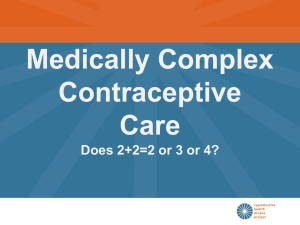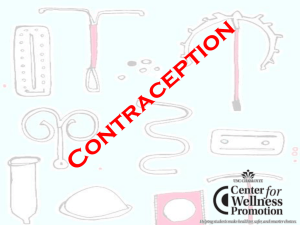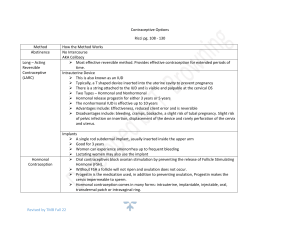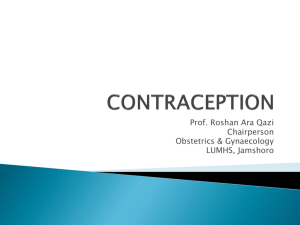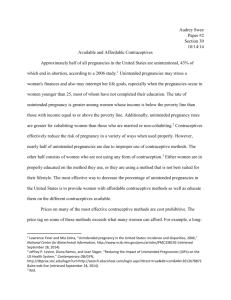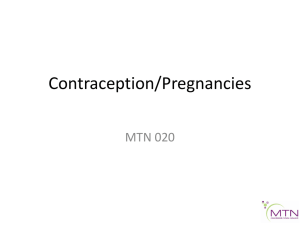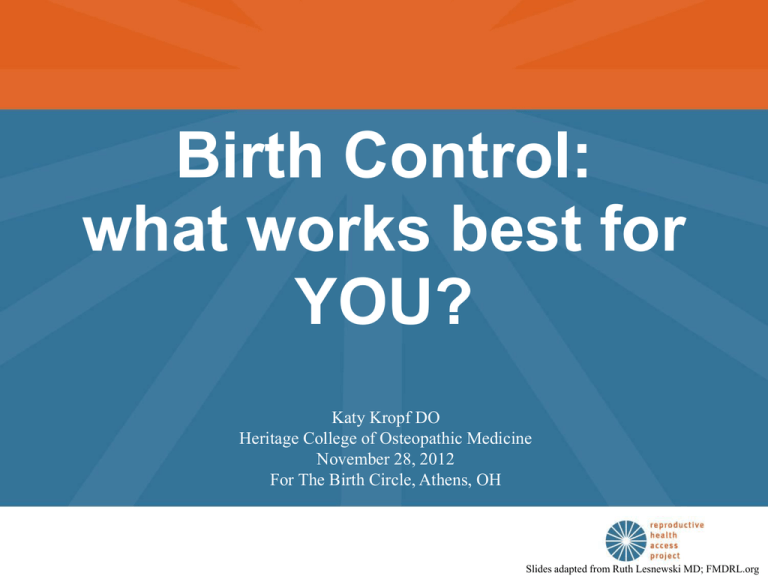
Birth Control:
what works best for
YOU?
Katy Kropf DO
Heritage College of Osteopathic Medicine
November 28, 2012
For The Birth Circle, Athens, OH
Slides adapted from Ruth Lesnewski MD; FMDRL.org
Nearly half of pregnancies in the
United States are unintended.
25 % Unintended
Used Contraception
52 %
Intended
23 % Unintended
No Contraception
Henshaw SK. Fam Plann Perspect. 1998;30(1):24-9, 46.
Rosenberg MJ, Waugh MS, Long S. J Reprod Med. 1995;40(5):355-60.
Potter L, et al. Fam Plann Perspect. 1996;28(4):154-8.
If no method is used to
prevent pregnancy, what is
the typical risk of pregnancy
after 1 year?
Emergency Contraception:
Levonorgestrel (Plan B One-Step)
Take at once
up to 5 days after unprotected
sex.
Lowers risk of pregnancy by
58-89%
Levonorgestrel EC:
Mechanism of Action
Inhibits ovulation
Does NOT cause abortion
Ulipristal acetate: Ella
a new emergency contraceptive option
Decreases risk of pregnancy by
about 90%
Nearly full efficacy up to 5 days after
unprotected intercourse
Requires Prescription
Why do women experience
unintended pregnancies?
Half of women at risk are not fully
protected from unintended pregnancy.
Nonuse all year 8%
Inconsistent use
- 27%
At-risk gap use 15%
Consistent, longacting method
use - 50%
Fertility Awareness Methods
(aka natural family planning)
As commonly used: approx. 25 pregnancies per 100
women using this method.
BUT with correct and consistent use, pregnancy
rates can range from 1-9 per 100 women using this
method.
• Calendar based methods (tracking your cycles)
• Symptom based methods (cervical secretions,
temperature)
Cyclebeads.com
Highly Effective Methods
Family Planning Typical-Use Rate Perfect-Use Rate
Method
of Pregnancy
of Pregnancy
Male and female
sterilization
0.2%-0.5%
0.1%-0.5%
Implants
0.1%
0.1%
Hormone shot
0.3%
0.3%
Intrauterine
devices
0.8%-2%
0.6%-1.5%
NOT USER DEPENDENT
Vasectomy
Condoms Withdrawal
Tubal Ligation - “tubes tied”
Essure
Intrauterine Devices
IUD Myths Debunked
IUDs DO NOT raise risk of Pelvic infection
IUDs DO NOT raise risk of infertility.
IUDs DO NOT raise risk of ectopic pregnancy.
IUDs can be used safely by women who’ve never been
pregnant and teens
IUD Myths Debunked
IUDs DO NOT cause abortion.
OK to insert IUD at any point in the
menstrual cycle.
OK to insert immediately after delivery
(post-partum) or following surgical
abortion
Progestin IUD (MIRENA)
Progestin Implant: Nexplanon
•
•
•
•
•
Highly effective and rapidly reversible
Discreet
Not user-dependent
Contain no estrogen
Can be used during lactation
Features of Progestin Implants
Can cause spotting
Requires certified
clinician visits for
insertion and
removal
Progestin-Only Injection
Hatcher, R et al. A Pocket Guide to Managing Contraception, 2007-2008
Depo Provera & Bone Density
“No need to restrict
Depo Provera use
because of bone
density concerns”
-ACOG
LAM: Lactational Amenorrhea Method
A woman can use LAM if:
1. Her period has NOT returned
2. She is breastfeeding on demand (at least
every 4 hours during the day, every 6 hours
at night) and not pumping
3. Her baby is less than 6 months old
• If any of these factors are not in place, risk of
pregnancy increases and additional methods should be
used
• Risk of pregnancy < 2% (and may be lower)
Hormonal Contraceptives
What is needed before prescribing?
Medical history
REQUIRED
Pap smear
Pelvic/breast exam
STI testing
Hemoglobin
NOT REQUIRED
Blood pressure
RECOMMENDED
Progesterone Only: Mini Pill
• ONE pill every day
– No breaks between packs
• Safe for breastfeeding women & babies
• Adds to the contraceptive effect of
breastfeeding
– Together, they provide effective pregnancy
protection
• Bleeding changes are common but not
harmful
Hormonal Contraception: Benefits
•
•
•
•
•
•
Birth Control
Decreased bleeding
Decreased anemia
Decreased menstrual pain
Decreased PMS
Decreased ACNE
• Decreased endometrial
and ovarian cancer
• Decreased benign breast
conditions
• Decreased ectopic
pregnancies
Hormonal Contraceptives
Who can’t use estrogen?
Estrogen contraindications:
• Migraine with aura
• Uncontrolled high blood pressure
• Postpartum < 6 weeks
• History of blood clot
Smoking: NOT a contraindication
in women/teens under age 35
When can you start the pill?
Extended Cycle Regimens
Estrogen/progestin vaginal ring
• Active for at least 3 weeks
• May remove for up to 3 hours
• Can do “QuickStart” same as
with pills
Estrogen / Progestin Patch
• 1 patch weekly for 3 weeks, then one week off
• OK to shower, swim, exercise with patch on
• Failures in trials were in women over 198
pounds, but still rare
Gallo MF, et al. Cochrane Reviews. 2003, Issue 1. Art. No. CD003552.
Jick S, et al. Contraception 73 (2006)
Getting the most out of your next
provider visit
Start thinking about and discussing your next method of
birth control before your baby is born
Do some research (ex. My Method at Planned
Parenthood) http://www.plannedparenthood.org/all-access/my-method-26542.htm
Come prepared:
•Write down what you want from your birth control
•Write down your questions
•Ask about side effects
•Ask your provider for a full year prescription
References and Resources
• Hatcher et al, Contraceptive Technology 2007
• Managing Contraception – book online @
www.managingcontraception.org
• Medical Eligibility Criteria for Contraceptive Use 2010 by WHO
www.who.int/reproductive-health
• Association of Reproductive Health Professionals www.arhp.org
• Alan Guttmacher Institute www.agi-usa.org
• Planned Parenthood www.plannedparenthood.org
• The Cochrane Collaboration www.cochrane.org
• www.Not-2-Late.com
• Reproductive Health Access Project www.reproductiveaccess.org


